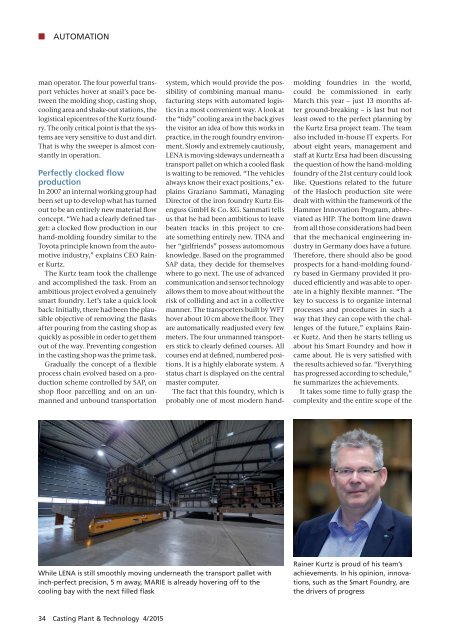CPT International 04/2015
The leading technical journal for the global foundry industry – Das führende Fachmagazin für die weltweite Gießerei-Industrie
The leading technical journal for the
global foundry industry – Das führende Fachmagazin für die
weltweite Gießerei-Industrie
You also want an ePaper? Increase the reach of your titles
YUMPU automatically turns print PDFs into web optimized ePapers that Google loves.
K AUTOMATION<br />
man operator. The four powerful transport<br />
vehicles hover at snail’s pace between<br />
the molding shop, casting shop,<br />
cooling area and shake-out stations, the<br />
logistical epicentres of the Kurtz foundry.<br />
The only critical point is that the systems<br />
are very sensitive to dust and dirt.<br />
That is why the sweeper is almost constantly<br />
in operation.<br />
Perfectly clocked flow<br />
pro duction<br />
In 2007 an internal working group had<br />
been set up to develop what has turned<br />
out to be an entirely new material flow<br />
concept. “We had a clearly defined target:<br />
a clocked flow production in our<br />
hand-molding foundry similar to the<br />
Toyota principle known from the automotive<br />
industry,” explains CEO Rainer<br />
Kurtz.<br />
The Kurtz team took the challenge<br />
and accomplished the task. From an<br />
ambitious project evolved a genuinely<br />
smart foundry. Let’s take a quick look<br />
back: Initially, there had been the plausible<br />
objective of removing the flasks<br />
after pouring from the casting shop as<br />
quickly as possible in order to get them<br />
out of the way. Preventing congestion<br />
in the casting shop was the prime task.<br />
Gradually the concept of a flexible<br />
process chain evolved based on a production<br />
scheme controlled by SAP, on<br />
shop floor parcelling and on an unmanned<br />
and unbound transportation<br />
system, which would provide the possibility<br />
of combining manual manufacturing<br />
steps with automated logistics<br />
in a most convenient way. A look at<br />
the “tidy” cooling area in the back gives<br />
the visitor an idea of how this works in<br />
practice, in the rough foundry environment.<br />
Slowly and extremely cautiously,<br />
LENA is moving sideways underneath a<br />
transport pallet on which a cooled flask<br />
is waiting to be removed. “The vehicles<br />
always know their exact positions,” explains<br />
Graziano Sammati, Managing<br />
Director of the iron foundry Kurtz Eisenguss<br />
GmbH & Co. KG. Sammati tells<br />
us that he had been ambitious to leave<br />
beaten tracks in this project to create<br />
something entirely new. TINA and<br />
her “girlfriends” possess automomous<br />
knowledge. Based on the programmed<br />
SAP data, they decide for themselves<br />
where to go next. The use of advanced<br />
communication and sensor technology<br />
allows them to move about without the<br />
risk of colliding and act in a collective<br />
manner. The transporters built by WFT<br />
hover about 10 cm above the floor. They<br />
are automatically readjusted every few<br />
meters. The four unmanned transporters<br />
stick to clearly defined courses. All<br />
courses end at defined, numbered positions.<br />
It is a highly elaborate system. A<br />
status chart is displayed on the central<br />
master computer.<br />
The fact that this foundry, which is<br />
probably one of most modern handmolding<br />
foundries in the world,<br />
could be commissioned in early<br />
March this year – just 13 months after<br />
ground-breaking – is last but not<br />
least owed to the perfect planning by<br />
the Kurtz Ersa project team. The team<br />
also included in-house IT experts. For<br />
about eight years, management and<br />
staff at Kurtz Ersa had been discussing<br />
the question of how the hand-molding<br />
foundry of the 21st century could look<br />
like. Questions related to the future<br />
of the Hasloch production site were<br />
dealt with within the framework of the<br />
Hammer Innovation Program, abbreviated<br />
as HIP. The bottom line drawn<br />
from all those considerations had been<br />
that the mechanical engineering industry<br />
in Germany does have a future.<br />
Therefore, there should also be good<br />
prospects for a hand-molding foundry<br />
based in Germany provided it produced<br />
efficiently and was able to operate<br />
in a highly flexible manner. “The<br />
key to success is to organize internal<br />
processes and procedures in such a<br />
way that they can cope with the challenges<br />
of the future,” explains Rainer<br />
Kurtz. And then he starts telling us<br />
about his Smart Foundry and how it<br />
came about. He is very satisfied with<br />
the results achieved so far. “Everything<br />
has progressed according to schedule,”<br />
he summarizes the achievements.<br />
It takes some time to fully grasp the<br />
complexity and the entire scope of the<br />
While LENA is still smoothly moving underneath the transport pallet with<br />
inch-perfect precision, 5 m away, MARIE is already hovering off to the<br />
cooling bay with the next filled flask<br />
Rainer Kurtz is proud of his team’s<br />
achievements. In his opinion, innovations,<br />
such as the Smart Foundry, are<br />
the drivers of progress<br />
34 Casting Plant & Technology 4/<strong>2015</strong>


















